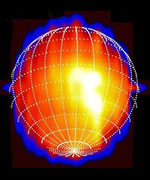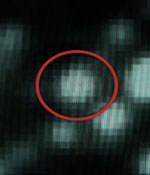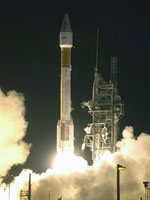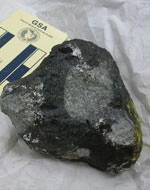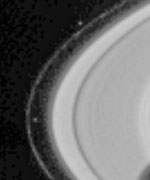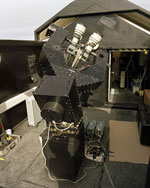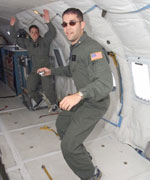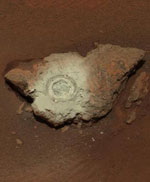
Image credit: NASA/JPL
Steve Squyres, the principal investigator for the Mars Exploration Rover, wrote in his science journal for April 16 that “Well, the Battle of Bounce Rock is over.”
Squyres was referring not only to the odd rock that rests alone on the otherwise flat, rockless Meridiani plains, but also what battles had to be waged even to consider it a rock at all.
“Not everybody on the team was even convinced that it was a rock at first,” noted Squyres. “There was some speculation that it might actually have been one of the airbag covers, shaken off during the landing by a particularly sharp jolt. Before we got to it we had a little guessing game going, with the votes about evenly split between ‘Mars rock’ and ‘flight hardware’, along with a few brave souls who thought it might be a meteorite.” Flight hardware has presented a number of fantastic images in the landscape, from objects like airbag threads and parachutes to tiny paper bits.
“There was only one object anywhere outside Eagle crater that looked even remotely like a decent-sized rock. We named it ‘Bounce Rock’ because we could see that the airbags had bounced right on top of it as the landing took place,” wrote Squyres. “It figures that if there was only one rock for what seems like miles in every direction, we’d find a way to hit it!”
“It was fun, and it sure was interesting, but it was a bit of a struggle,” described Squyres. “What had us going for awhile there was a very nice Mini-TES spectrum that seemed to show a lot of hematite in the rock. We knew there was hematite in the soil at Meridiani, but this was the first time we’d gotten a hematite signal from rock… so it looked very interesting. We rolled up to it, whipped out the Moessbauer Spectrometer, took some good data, and to our surprise we found no hematite in the rock at all. In fact, the only mineral that the Moessbauer detected was pyroxene, which made this rock look very different from anything we’d ever seen, at either landing site. We put a hole in it with the RAT, looked again, and saw the same thing — lots of pyroxene and no hematite.”
“So what was going on?”, asked Squyres. “Turns out we’d been faked out on the Mini-TES data. We had been pretty far away from the rock when we had first looked it, and the Mini-TES field of view had also included a particularly hematite-rich patch of soil immediately behind the rock. Once we got close enough to see the rock better with Mini-TES, the Mini-TES data confirmed the absence of hematite, confirmed the pyroxene, and also showed some plagioclase, another mineral, in the rock. So the story was coming together.”
“Then came the most interesting part of all, the APXS data.” Squyres referred to the alpha proton spectrometer, an instrument to determine chemical composition. “The APXS measures elemental chemistry, and what we found was that, chemically, Bounce Rock is almost a dead ringer for a rock called EETA 79001-B. Odd name for a rock; 79001 actually is a rock from Mars that was found in Antarctica back in 1979. It was knocked off of Mars long ago, orbited the sun for awhile, and eventually hit the Earth in Antarctica, where it was found many years later by an expedition sent there to collect meteorites. There are more than a dozen such rocks that are believed to be from Mars on Earth. But until Bounce Rock, nobody had ever found a rock that was actually on Mars and that matched the chemistry of one of these rocks. Now we have.”
“We’re not quite sure where on Mars Bounce Rock came from, but we suspect that it might have been thrown out of a big impact crater that’s about 50 kilometers southwest of our landing site,” concluded Squyres. “So it’s not a meteorite, but it probably did fall from the sky. And it turned out to be a very interesting stop on our drive across Meridiani Planum.”
The rover team has two hills on the horizon, each approaching closer everyday, as Spirit drives towards the Columbia Hills and Opportunity motors towards Endurance Crater with a slightly raised lip that otherwise stands out as the closest thing to a hill on the flat plains.
On its way to the Columbia Hills, Spirit acquired new microscopic imager views of its capture magnet on sol 92 (April 6, 2004). Both Spirit and Opportunity are equipped with a number of magnets. The capture magnet, as seen right, has a stronger charge than its sidekick, the filter magnet. The lower-powered filter magnet captures only the most magnetic airborne dust with the strongest charges, while the capture magnet picks up all magnetic airborne dust.
The magnets’ primary purpose is to collect the martian magnetic dust so that scientists can analyze it with the rovers’ Moessbauer spectrometers. While there is plenty of dust on the surface of Mars, it is difficult to confirm where it came from, and when it was last airborne. Because scientists are interested in learning about the properties of the dust in the atmosphere, they devised this dust-collection experiment.
The capture magnet is about 4.5 centimeters (1.8 inches) in diameter and is constructed with a central cylinder and three rings, each with alternating orientations of magnetization. Scientists have been monitoring the continual accumulation of dust since the beginning of the mission with panoramic camera and microscopic imager images. They had to wait until enough dust accumulated before they could get a Moessbauer spectrometer analysis. The results of that analysis, performed on sol 92, have not been sent back to Earth yet.
The plains appear to be uniform in character from the rover’s current position all the way to Endurance Crater. Granules of various sizes blanket the plains. Spherical granules fancifully called blueberries are present – some intact and some broken. Larger granules pave the surface, while smaller grains, including broken blueberries, form small dunes. Randomly distributed 1-centimeter (0.4 inch) sized pebbles (as seen just left of center in the foreground of the image) make up a third type of feature on the plains. The pebbles’ composition remains to be determined. Scientists plan to examine these in the coming sols.
Examination of this part of Mars by NASA’s Mars Global Surveyor orbiter revealed the presence of hematite, which led NASA to choose Meridiani Planum as Opportunity’s landing site. The rover science conducted on the plains of Meridiani Planum serves to integrate what the rovers are seeing on the ground with what orbital data have shown. Opportunity will make stop at a small crater called “Fram” (seen in the upper left, with relatively large rocks nearby) before heading to the rim of Endurance Crater.
Original Source: NASA Astrobiology Magazine

